Representation of madness in Kesey’s "One flew over the cuckoo’s nest"
Daphne Miller
When Emily Dickinson wrote Much madness is divinest sense in 1862 she was subverting the conventions of her time by critiquing society’s treatment of madness as anything that lies outside the limits of social conformity. In the 1960s a similar critique was echoed by one of modernity’s most fervent critics, Michel Foucault. In A History of Madness Foucault writes that during the Age of Reason, "madness is, gathered into a single point, the whole of unreason" (Gutting, 1994: 62).
1. A theorical approach to madness
2. Madness in One flew over the cuckoo's nest
3. Gender stereotypes through Nurse Ratched and McMurphy
4. The power of conformity: two victims of madness
5. Kesey's messages through the novel
6. Conclusion
7. Bibliography
1. A theorical approach to madness
Similarly to Dickinson, Foucault suggests that modernity operates by classifying humanity into binary categories. In attributing to some the status of ‘reasonable’ and naming others ‘unreasonable’, society separates the rational from the mad and perpetuates certain kinds of reason as legitimate while excluding others. In Dickinson’s words: "Assent - and you are sane - Demur - you’re straightway dangerous" (Much madness is divinest sense).
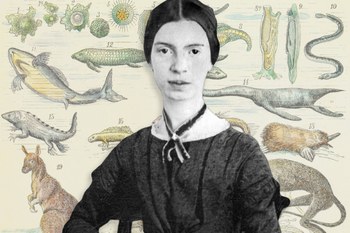
However, unlike Dickinson who turned to the divine to rescue madness from punishment, Foucault focuses on mental institutions, arguing that their emergence coincided with the formation of medical discourses that pathologised certain types of behaviour as beyond normality. Indeed, as Gary Gutting argues, "Foucault’s history of madness in the Classical Age is intended as a basis for showing that madness as mental illness was a social construction" (1994: 53). Foucault’s argument is drawing upon earlier critiques of reason, such as Adorno and Horkheimer’s attack on the instrumental rationality of modernity for "falling prey to tendencies toward… conformity" (Kellner, 2014). Indeed, Douglas Kellner echoes their argument, "while culture once cultivated individuality, it was now promoting conformity, and was a crucial part of 'the totally administered society' that was producing 'the end of the individual'’ (ibid.). Kellner’s critique of modernity establishes an explicit link between the pressures of social conformity and the formation of subjects that lack individuality. Whereas this is not directly an attack on madness, it does suggest that there is something fundamentally wrong in the production of uniform social selves and that freedom and thus sanity lie in the cultivation of individuality.
2. Madness in One flew over the cuckoo's nest
Ken Kesey’s One flew over the cuckoo’s nest extends both Foucault’s insight of madness as resting on discursive binaries and Kellner’s critique of conformity as the lack of individuality. Kesey explores these binaries through two characters: Nurse Ratched, the archetypal female and institutional carer, and Randle McMurphy, the archetypal male and the institutionalised inmate. Both characters follow social roles that alienate them from their true self: Nurse Ratched obeys the regulations of the Mental Institute and McMurphy yields to the pressures of his inmate peers. They can thus both be seen as neglecting their individuality. It is precisely this neglect that proves to be madness, as it perpetuates the strict binaries of reason and unreason while, as Kesey further suggests, it is in the discovery of the inner self that sanity lies. Although this belief in authentic interiority is rejected by Foucault, Kesey echoes Foucault both in his exploration and deconstruction of social binaries. It is a third character, Chief Bromden, that enables Kesey to imply that transcending the social classifications of madness means finding one’s own voice. Bromden achieves this transcendence through his liminal position as both an inmate and an observer/narrator who breaks free from the Institution and finds sanity. Nurse Ratched and McMurphy will thus be explored through the gender and institutional binaries that constrain them, and contrasted with Bromden’s ambiguous relationship to authentic selfhood.
3. Gender stereotypes through Nurse Ratched and McMurphy
Contrasting gender stereotypes offer insights into Nurse Ratched and McMurphy’s binaries. In light of Kellner’s observation that society promotes conformity that is leading to the end of the individual, both characters fail to voice their own individuality and so fail to escape compliance and thus madness.
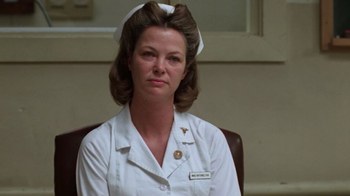
Nurse Ratched is depicted as conforming to the role of archetypal female. One example is her infantilisation of the inmates and her manipulation of the maternal role. When Billy is found in bed with Candy, Nurse Ratched put a "hand on his neck and drew his cheek to her starched breast" (Kesey, 2005: 381). She manipulates the maternal role by putting a hand on his neck and implicitly assigning him the role of the infant in need of her breast. Billy’s infantilisation is further evident when she strokes him and says "poor boy, poor little boy" (ibid.: 381). Her maternal role is further reflected in the descriptions of group therapy, described by McMurphy as a "pecking party" (ibid.: 72) where Nurse Ratched inevitably becomes the pack leader - the mother of the nest. Harding asks McMurphy, "Where is Miss Ratched pecking?" to receive the reply, "At your balls, buddy at your everlovin’ balls" (ibid.: 75). The vivid brutality of the pecking imagery represents Nurse Ratched’s active attempt to emasculate the men. She becomes the domineering female whose power threatens the inmates’ masculinity, triggering McMurphy to call her a "ball-cutter" (ibid.). Her femininity is narrated in such violent and hyperbolic terms that, instead of being an individual, she turns into a particular stereotype of femininity: the symbol of threatening, overbearing motherhood. However, it is Bromden’s subjective narrative that constructs Nurse Ratched’s femininity in a stereotypical manner, rendering Nurse Ratched’s role of the archetypal female a mere projection. From this perspective, her individuality is lost under the gaze of male objectification. Bromden’s narrative serves to emphasise Nurse Ratched’s breasts as the key characteristic of her womanliness: "big, womanly breasts" (ibid.: 10), "extraordinary breasts" (ibid.: 90), the "actual inch-by-inch measurement" (ibid.: 191) of her breasts.
The breasts take on life of their own due to the hyperbolic adjectives used to describe them, which makes them aggressive and intimidating. It is thus Ratched’s overwhelming physicality, through the breast imagery, that the inmates feel oppressed by. In this respect, Harding’s insight that the inmates are all "victims of a matriarchy" (ibid.: 79) is significant in understanding the second way Nurse Ratched takes on an abstraction at the expense of her individuality. This insight is confirmed by Brian Stagoll’s characterisation of Nurse Ratched as "the… deadly matriarchal destroyer of manhood" (Stagoll, 2003: 118), which goes beyond the conflicting categories of masculinity and femininity, much like Foucault’s reason and unreason, and evokes Nurse Ratched’s body as a symbol of menacing femininity. Indeed, as Daniel J. Viktus argues, "In the struggle between McMurphy and Big Nurse, Good and Evil are represented in the form of Male and Female" (Vitkus,1994: 77). Nurse Ratched becomes here a signifier that subordinates an individual self not only to the generic category of female but also to an abstraction, Evil. Again, Nurse Ratched’s individuality seems lost, as she both participates in the binary of gender roles and, consequently, comes to represent a generic femininity of threat.
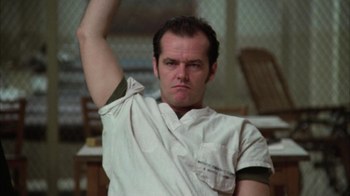
McMurphy is evidently the counter-force to Nurse Ratched. His masculinity is asserted in Bromden’s first description. McMurphy is "broad across the jaw and shoulders and chest (…) a seam runs across his nose and one cheekbone where somebody laid him a good one in a fight" (Kesey, 2005: 17). His description draws on a series of stereotypical male properties: strong, large and feisty. However, similarly to Nurse Ratched, it is Bromden’s own projections that are instrumental for the construction of McMurphy’s hyper-masculine ideal identity. Bromden’s mention of McMurphy’s "big and beat up" (ibid.) hands is significant because these hands become an exemplary motif for his masculinity. As Vitkus argues, "It is the text’s celebration of male strength, exemplified in these images of the male hand" (1994: 77). For instance, McMurphy "puts that big red hand on Billy’s thin arm" (Kesey, 2005: 26). The contrast in size between McMurphy and Billy serves to further establish McMurphy as the alpha male. Subsequently, Bromden remembers that the fingers "were thick and strong closing over mine, and my hand commenced to feel peculiar and went to swelling up out there on my stick of an arm" (ibid.: 33). Bromden’s hand takes on phallic imagery in its swelling on the end of a stick. By associating McMurphy with sexual arousal, his role as the stereotypical, sex-driven masculine energy of the novel is undeniable. McMurphy, similarly to Nurse Ratched, becomes here a signifier for masculinity. He is recognised as an abstraction rather than a person and his individual character is lost.
4. The power of conformity: two victims of madness
If the attack on instrumental rationality as a means to tyrannically impose conformity and dismiss individuality can be seen as a form of insanity, then both Nurse Ratched and McMurphy may be seen as victims of conformity, and by extension, victims of madness. However, this is not solely due to their submission to tyrannical femininity and hyper masculinity, but also because they submissively follow their institutional roles of employee and inmate. For example, Nurse Ratched’s professional smile is described as consciously forced: "painted smile" (ibid.: 9), "white knot of tight-smiled fury" (ibid.: 36), "She walks around with that same doll smile crimped between her chin and her nose" (ibid.). "Painted" implies that the smile is fake, probably concealing truer emotions. "Tight-smiled" and "crimped between her chin and her nose" suggest that the smile should not naturally be there. When Nurse Ratched discusses the potential use of the other day room with Dr. Spivey, "She doesn’t answer, and she doesn’t care much for his joking (…) but her face doesn’t change. The smile stays" (ibid.: 138). Nurse Ratched’s artificial smile reflects "emotional labour, [that is] the act of expressing socially desired emotions during service transactions" (Hoschild, 1983: 88) and suggests that her professional performance is calculated and theatrical. Her authentic self is hidden behind the institutional pressure of conforming to her role as an employee. The insanity lies in the standardisation of behaviour and emotion that the impersonal institution obliges her to submit to, depriving her of the possibility to be true to herself.
5. Kesey's messages through the novel
Kesey’s message appears to be that in order to be sane, you must resist social conventions and nurture your individual voice. Accordingly, Thomas H. Fick argues that McMurphy, “teaches [the inmates] to replace an imposed identity with an imagined identity of their own creation” (Fick, 1989: 21-22). For example, McMurphy reimagines Billy as Billy Club Bibbit where anyone would see "him and says 'Are you the renowned Billy Club Bibbit? Of the famous fourteen inches?”’ (Kesey, 2005: 126). However, Fick’s point is limited. McMurphy may value individual identity over imposed identity, but he is himself incredibly restricted by conventional masculine expectations.
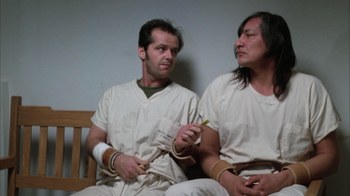
For example, Billy’s reimagined identity is itself highly determined by masculine stereotypes - his worth is to a large extent determined by the size of his penis. Nor does McMurphy appear to behave himself in a way that corresponds to a true self. Bromden observes that he'd "see him do things that didn’t fit with his face or hands" (ibid.: 195), implying that there were inconsistencies between his public and his private behaviour. Later in the novel, on the way back from the fishing trip, Bromden sees "an expression that was allowed only because he figured it’d be too dark for anybody in the car to see" (ibid.: 309). Again, this glimpse of a different McMurphy in the dark, demonstrates how his true self is hidden underneath his efforts to conform to a certain image. Fick likens McMurphy to a modern superhero but makes a distinction: "the modern superhero can alternate between the spectacularly public and entirely private (…) McMurphy is an undivided man" (Fick, 1989: 25). In other words, McMurphy is not able to manoeuvre between his public and private selves: he remains mostly a public performance. Although to a lesser degree than Nurse Ratched, McMurphy, too, appears to conform to external and thus oppressive pressures placed upon him by his peers. In doing so, he loses his individuality and consequently risks his own sanity.
Kesey’s message that independence and individuality are instrumental to a sane mental state is best exemplified through Chief Bromden. Bromden’s character suggests that the possibility of resistance cannot reside in occupying either side of the gender and institutional binaries, as Nurse Ratched and McMurphy do. Fred Madden argues, "Nurse Ratched acts as an agent who enforces a conformity to the rules of 'outside society', whereas McMurphy becomes an agent of conformity to the wishes of the ward members' 'inside society'’ (Madden, 1986: 207). By contrast, Bromden stands out in demonstrating the importance of the liminal or the betwixt-and-between position (Turner, 1987: 3). He both participates in the discourse of madness as a member of the institution, and simultaneously, by pretending to be mute and deaf, avoids active participation in the discourse. Unlike Nurse Ratched and McMurphy’s social performances, Bromden’s deaf and mute act is one of resistance and not conformity. This becomes evident when Bromden begins to explain his memories: "Papa says if you don’t watch it people will force you one way or the other, into doing what they think you should do, or into just being mule-stubborn and doing the opposite out of spite" (Kesey, 2005: 250). Here, Bromden’s reason for taking on the mute/deaf role could be regarded as one of resistance. His role allowed him to exercise agency, in that he is the one hearing "all the scheming and treachery that had gone on when she didn’t think anybody was listening" (ibid.: 249); his power lies in understanding interactions that he is not thought to be perceiving. Bromden’s capacity to be both silent witness and participant in the ward helps him challenge conformity and instead cultivate individuality. Indeed, Bromden is ultimately the only one who escapes the hospital’s controlling grip and finds a voice to tell his story. His exit is symbolic in that he throws the control "panel through the Screen and window with a ripping crash" (ibid.: 391), in contrast to other inmates who sign themselves out. This escape implies that Bromden actively revolts and breaks free of institutional control.
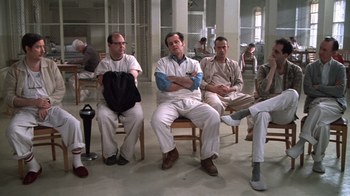
This conception of effective resistance as a boundary position resonates with Foucault’s view that there is no possibility to fully escape power, as we are constituted as subjects precisely through the power relations of discourse. However, it is possible to establish temporary points of resistance that allow us to negotiate our status within these power relations and, at least provisionally, challenge its binary classifications. Indeed, Madden argues that, "Kesey wants the reader to see that Bromden’s sanity results from his own actions" (1986: 211). Bromden’s final extract is littered with the pronoun "I" and agentive verbs such as "I might", "I’ll stop", "I’d like", "I’d give". He achieves his individuality, and by extension his sanity, by asserting himself as a decision-maker. Furthermore, the novel’s last paragraph emphasises possibility; Bromden plans his future by pursuing his own individual needs and preferences, rather than conforming to the institution. Of course, there is a complication in Bromden’s ability to break free. Although the last paragraph of the novel does show examples of agency, the final line, "I been away a long time" is ambiguous. It could be interpreted as referring to his physical absence from the Columbian gorge: Bromden has escaped the oppressive forces of the Institution in order to literally go home. However, the statement could also be interpreted as a mental absence from society. The institution has tainted Bromden’s freedom in alienating him from the conventions of society. Despite his physical freedom, the ambiguity of the last line suggests that Bromden may not have fully escaped the psychological impact of the institution.
6. Conclusion
Although Kesey consistently explores agency and individuality through Bromden’s liminal figure in a world of binaries, such as female/male or sane/insane, and of perpetual conformity to these binaries, the final sentence complicates the dream of total freedom from conformity. In suggesting that even characters who transcend the binaries seem unable to fully escape the social trap of conformity, it raises doubt over the possibility of true individuality and complete sanity as an achievable goal. Even though Kesey’s novel fully resonates with Dickinson’s dictum, "Assent - and you are sane - Demur - you’re straightway dangerous" , ultimately it seems to also question the ideal of constant resistance. While it does indeed demonstrate how instrumental rationality, and by extension, conformity, leads to the end of the individual and consequently, sanity, the novel goes further than this. It demonstrates that the psychological project of modernity, to find a true self or be a normal mind is out of reach because we are all constructed through social conventions and, inevitably, live through them. All we can do, perhaps, is move between them.
7. Bibliography
Dickinson, Much Madness Is Divinest Sense, Poetryfoundation.org (data di ultima consultazione 25/08/2021).
Fick Thomas H., "The Hipster, The Hero, And The Psychic Frontier In One Flew Over The Cuckoo's Nest", in Rocky Mountain Review, n. 43,1989, pp. 19-34 (data di ultima consultazione 25/08/2021).
Gutting Gary, The Cambridge Companion To Foucault, 1994.
Hochschild Arlie Russell, The Managed Heart, 1983.
Kellner Douglas, T.W. Adorno And The Dialectics Of Mass Culture, 2014.
Kesey Ken, One Flew Over the Cuckoo’s Nest, 2005
Madden Fred, "Sanity And Responsibility: Big Chief As Narrator And Executioner", in MFS Modern Fiction Studies, n. 32, 1986, pp. 203-217 (data di ultima consultazione 25/08/2021).
Stagoll Brian, "One Flew Over The Cuckoo's Nest",in Australian & New Zealand Journal of Psychiatry, n. 37, 2003, pp. 118-122 (data di ultima consultazione 24/08/2021).
Turner Victor, Betwixt & Between: Patterns of Masculine and Feminine Initiation, 1987.
Vitkus, "Madness And Misogyny In Ken Kesey's One Flew Over The Cuckoo's Nest" in Alif, Journal of Comparative Poetics, 64, 1994 (data di ultima consultazione 24/08/2021).
Foto 1 da Pangea (data di ultima consultazione 24/08/2021).
Foto 2 da Everyeye.it (data di ultima consultazione 24/08/2021).
Foto 3 da Filmforlife (data di ultima consultazione 25/08/2021).
Foto 4 da The Harvard Crimson (data di ultima consultazione 25/08/2021).
Foto 5 da Qualcunoconcuicorrere (data di ultima consultazione 25/08/2021).